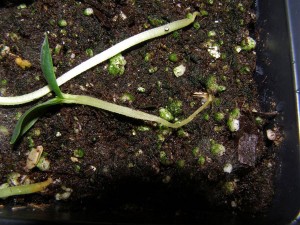One of the first problems that we encounter when growing from seed is the disease known as damping-off. Damping off is caused by fungi and fungus-like organisms. These attack seeds and seedlings as they begin to germinate and grow.
It can be demoralising for the new and experienced gardener alike when seedlings collapse and die just after they’ve emerged.
The first seed leaves (cotyledon), roots and stems of seedlings are highly susceptible to infection which will then cause the seedlings to wilt, fall over or even collapse in a mass of white fungal growth.
Damping off can affect most seedlings, particularly under levels of high humidity or poor air circulation. It is particularly a problem when sowing seed indoors or under glass but can affect seedlings sown outdoors too.
While damping off can happen at any time of the year, it’s most noticeable in spring when light levels and temperatures are low and seedlings grow slowly. Once plants have mature leaves and a well-developed root system, they are better able to naturally resist the damping off pathogens.

Image: Michelle Grabowski, http://www.extension.umn.edu
Causes of Damping Off:
Basically, Damping Off occurs were the fungal spores are present and they are given better growing conditions than the plant! Typically this occurs when the seed tray is kept cool, damp and in still air.
- While some commercial seedling compost is sterilised, garden compost or leaf mould will contain the fungi which cause damping off.
- Using dirty containers already colonised by the fungi.
- Seed planted in compost that is too cold for proper germination.
- Over-watering which enables the spread of the water born spores.
- Overcrowding seedlings can cause a humid micro-climate.
- Stress in the seedlings caused by low light and cool temperatures.
How to spot Damping Off
Damping off usually manifests itself in the stem of the seedling thinning and the plant falling over but you might also see the following symptoms:
- Seedlings may fail to emerge (pre-emergence damping off).
- Seedling stems become water soaked and thin, almost thread like, where infected.
- Young leaves wilt or discoloured (grey to brown).
- Roots are absent, stunted or are discoloured.
- Fluffy white cobweb like growth on the surface of the compost or even on infected plant parts.
Control of Damping Off
There were commercial fungicides available for the treatment of damping off until 2010 but these are now banned as they also harm the mycelium necessary for healthy plant growth. There are some preventative measures which can be used to prevent Damping off:
- Use a sterilised commercial compost (preferably peat free).
- Make sure your seed compost mix is light and fast-draining (adding perlite to the mix will help).
- If you are using your own compost or leaf mould, you can sterilise it in small quantities in the oven or even a microwave.
- The fungi which causes Damping Off can survive in very small quantities of soil or compost. For seedlings, use new or sterilised pots and trays. A scrub and a wash in a disinfectant such as Jeyes Fluid will do the trick.
- Sow seedlings thinly to avoid crowding (it also makes pricking out easier).
- Do not overwater. Ideally you should water your seed trays from below by standing them in a basin of clean water.
- Never water the seedlings or trays after noon so that the surface and the plants can dry before night.
- Keep seedlings well ventilated to reduce humidity. If you are using a small, cover propogator, open all of the vents.
- Do not use rain water from water-butts on your seedlings that could harbour some of the damping off fungi. If you are using a water from a butt, adding Potassium Permanganate crystals to the water will help to prevent problems from both damping off and algae.
- Fill your seed trays so that the soil surface is near the top of the tray. This will improve air circulation around the emerging seedlings.
Organic Controls of Damping Off
There are also some active measures that you can take to control Damping Off or to prevent it altogether:
- Lightly mist the compost and seedlings with nettle tea. This brew has anti-fungal properties.
- When sowing seeds dust the compost with powdered charcoal.
Treatment for Damping Off of Seedlings
There is no cure for plants that already have damping off so prevention is crucial. As well as the measures already mentioned, providing good air circulation over trays and around the seedlings will go a long way to prevent the problem.
Notes on the Biology of Damping Off
The fungi, Rhizoctonia spp. and Fusarium spp., along with the water mold Pythium spp. are the most common pathogens responsible for damping off.
All of these organisms colonise the delicate tissues of young seedlings and, in feeding from them, causes their death. The mycelium of the fungi are often visible as a whitish growth of mould on the rotting plants.
Mycologists consider Phytophthora to be a relatively primitive type of fungus because the spores are motile and require water for dispersal.
What I do to deal with Damping Off
I reuse seed trays, make my own seed compost and grow in a greenhouse – which can be warm and damp so Damping Off can be a problem.
To prevent Damping Off I use a warming cable to speed up germination, I avoid over-watering and I increase air circulation using a fan.
Sources
- The Royal Horticultural Society
- The University of Minnesota
- Planet Natural Research Center
- University of Vermont Extension Department of Plant and Soil Science
- Wikipedia
- Thompson & Morgan